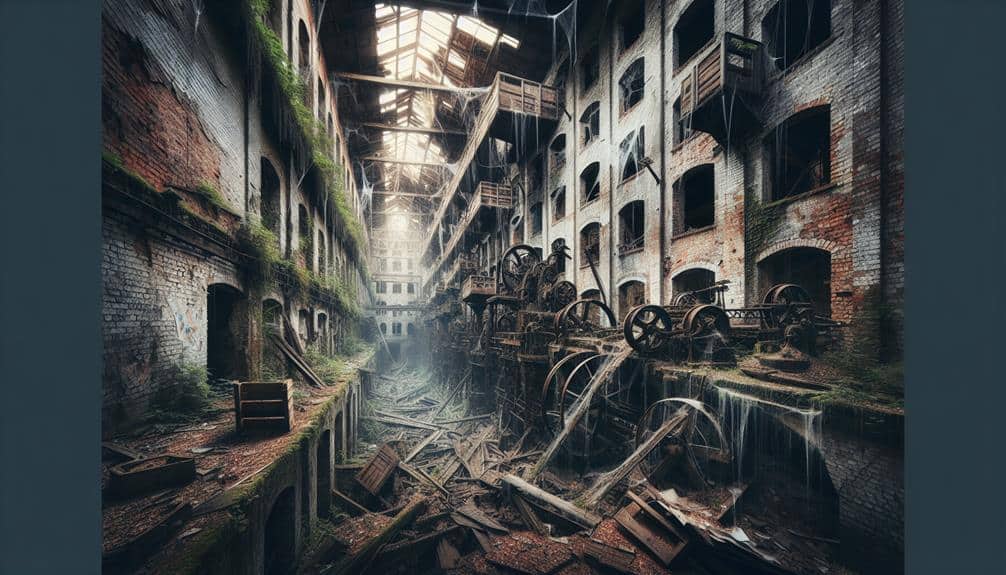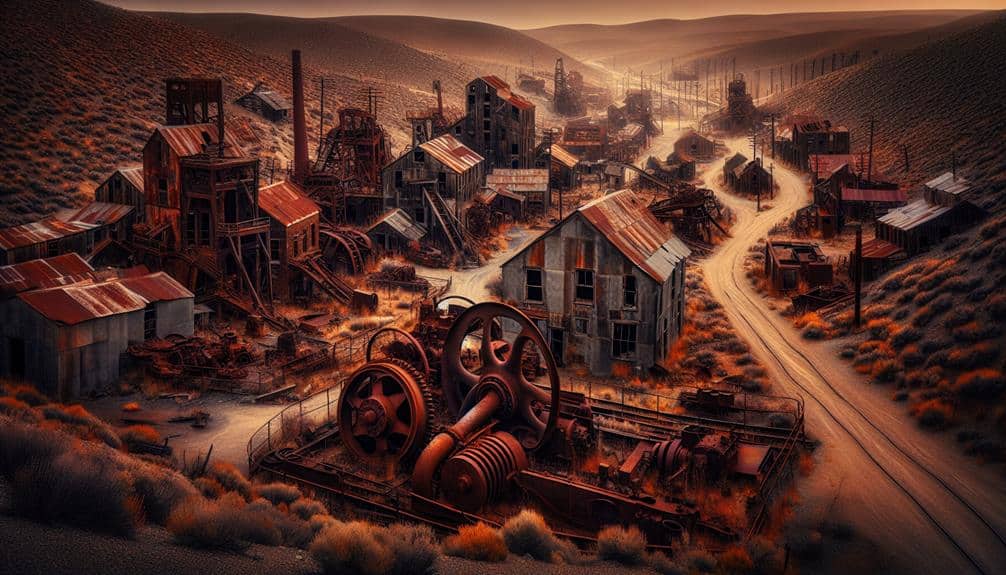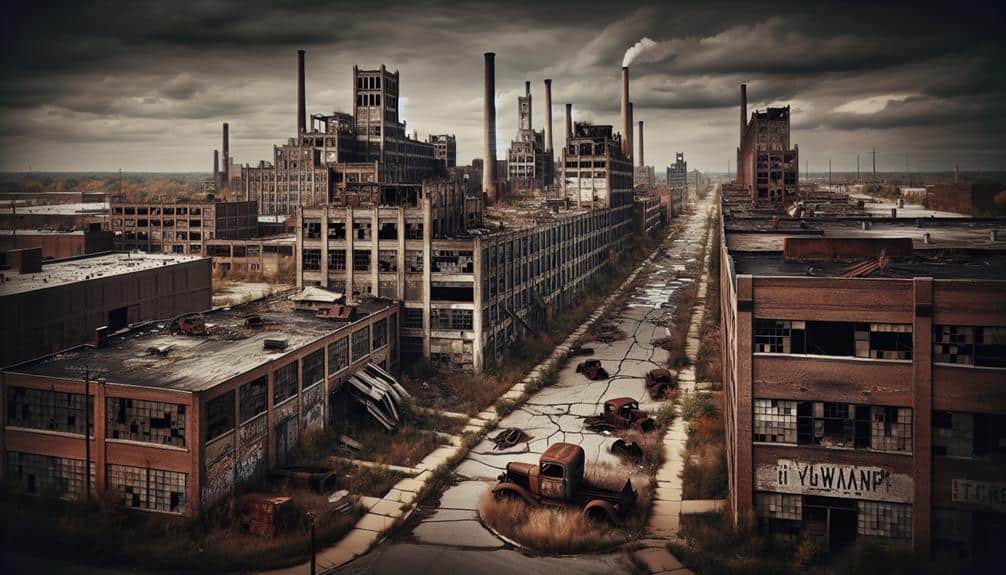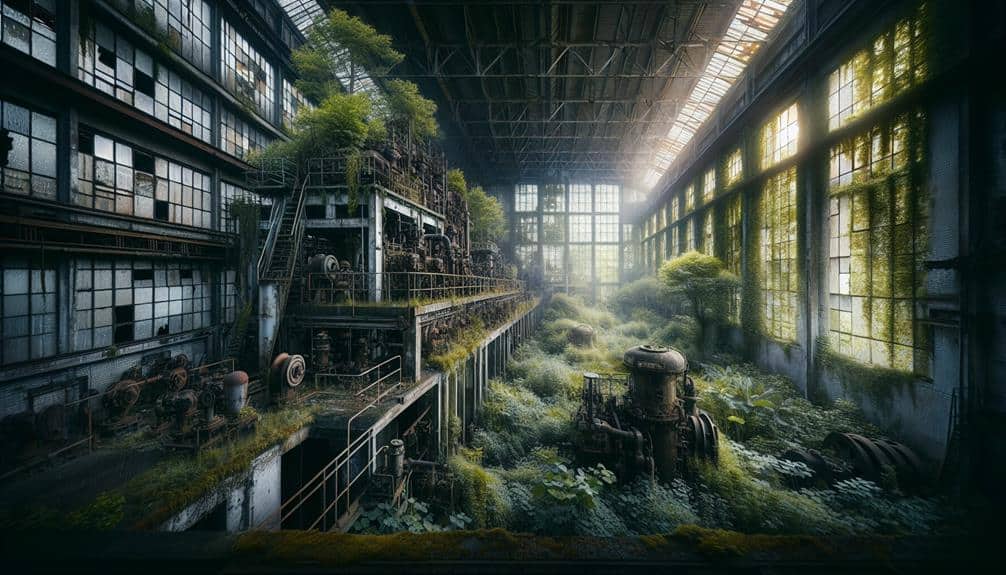Step immerse in time and discover the haunting beauty of historic textile mill ghost towns. Explore remnants of once-thriving communities, where echoes of bygone eras linger in the quiet decay of industrial relics. Witness the resilience of these tight-knit communities and the significant cultural impact they held. See the struggle against economic decline, environmental challenges, and financial burdens. Experience the ongoing preservation efforts and revitalization projects bringing new life to these places. Plunge into the stories woven into the fabric of mills, where past and present harmonize. Learn more about the promising future prospects awaiting these ghost towns.
Key Points
- Abandoned mill buildings, remnants of once-thriving industries.
- Historical artifacts, machinery, and equipment left behind.
- Empty streets and deteriorating infrastructure in former mill towns.
- Cultural remnants like traditions, stories, and community memories.
- Potential for revitalization through preservation and adaptive reuse.
Rise of Textile Mill Ghost Towns
During the Industrial Revolution, textile mill ghost towns began to emerge as once-thriving communities slowly faded into history. The economic impact of these ghost towns was profound, as the decline of textile mills led to widespread unemployment and financial hardship for the residents. The closure of these mills not only affected the workers directly but also had ripple effects on local businesses and the overall economy of the region.
These ghost towns held significant cultural significance as well. They were often tight-knit communities with strong traditions rooted in the textile industry. The abandoned mills became symbols of a bygone era, serving as reminders of the hard work and dedication of the people who once inhabited them. The rich history of these towns is a tribute to the resilience and spirit of the individuals who contributed to the growth of the textile industry.
As you explore these remnants of history, you can't help but feel a sense of reverence for the lives and livelihoods that once thrived in these now-desolate places. The rise and fall of textile mill ghost towns serve as a poignant reminder of the ever-changing landscape of industry and the enduring human spirit.
Factors Leading to Abandonment
The gradual erosion of economic viability and the evolution of industrial practices played pivotal roles in the abandonment of textile mill ghost towns. Textile mills faced a significant economic decline due to factors such as increased competition from overseas manufacturers offering lower production costs. This led to many mills struggling to remain profitable, forcing them to shut down operations.
The environmental impact of textile production also contributed to their abandonment. Pollution from dyeing processes and waste disposal practices contaminated surrounding areas, making them undesirable for continued habitation. As environmental regulations became stricter, mills faced pressure to update their facilities to meet standards, which posed additional financial burdens.
These combined factors made it increasingly challenging for textile mills to sustain operations, ultimately leading to the abandonment of many towns built around these once-thriving industries. The echoes of these ghost towns serve as reminders of the complex interplay between economic forces and environmental considerations in shaping our industrial heritage.
Preservation Efforts and Challenges
Preserving the remnants of historic textile mill ghost towns involves maneuvering a landscape fraught with unique challenges and opportunities for conservationists and historians alike. When delving into historic preservation efforts, you encounter a mix of emotions:
- Hope: Witnessing the dedication of individuals and communities working diligently to protect these sites ignites a sense of hope for the future of these ghost towns.
- Frustration: Dealing with limited resources, bureaucratic hurdles, and conflicting interests can lead to moments of frustration in the preservation process.
- Inspiration: Learning about the stories woven into the fabric of these textile mills can serve as a wellspring of inspiration for those working towards their conservation.
- Desire for Community Engagement: The key to successful preservation lies in fostering community engagement, where shared passion and collaboration can breathe new life into these historic sites.
Navigating the delicate balance between honoring the past and creating a sustainable future requires a deep commitment to historic preservation and active participation from the community.
Revitalization Projects in Progress
Starting on revitalization projects for historic textile mill ghost towns involves a strategic blend of innovative approaches and community-driven initiatives. Community engagement plays a pivotal role in these projects, fostering a sense of ownership and pride among residents. By involving the local community in decision-making processes, projects become more inclusive and reflective of the town's heritage.
Moreover, the economic impact of revitalization efforts can't be overstated. Restoring historic textile mill ghost towns can attract tourists, create job opportunities, and stimulate local businesses. As these towns regain their vibrancy, they contribute to the overall economic growth of the region.
Many revitalization projects also focus on preserving the historical significance of these ghost towns while adapting them to modern needs. By striking a balance between conservation and innovation, these projects ensure that the town's unique identity is maintained while fostering sustainable development.
Future Prospects for Ghost Towns
Considering the potential for growth and development, exploring future prospects for these historic textile mill ghost towns is an essential endeavor. As these towns stand as evidence to a bygone era, they hold promise for a vibrant future. Here are four key points to ponder:
- Preservation and Sustainable Development: Embracing sustainable practices in the restoration of these ghost towns can guarantee their longevity while safeguarding the environment for future generations to enjoy.
- Cultural Heritage Tourism: Leveraging the rich history and unique charm of these towns can create economic opportunities through tourism, attracting visitors keen to explore the stories embedded in their streets.
- Innovative Use of Space: Repurposing old mill buildings for modern businesses, artistic endeavors, or community spaces can breathe new life into these towns, fostering creativity and entrepreneurship.
- Community Engagement and Empowerment: Involving local residents in the revitalization efforts can instill a sense of pride and ownership, creating a sustainable future where the past and present harmonize to shape a prosperous tomorrow.
Frequently Asked Questions
What Types of Paranormal Activity Have Been Reported in Historic Textile Mill Ghost Towns?
When visiting historic textile mill ghost towns, you may encounter a variety of paranormal activity. Reports of eerie sightings, unexplained sounds, and ghostly apparitions are common. Local folklore often intertwines with the supernatural occurrences found during paranormal investigations.
Are There Any Famous Urban Legends or Myths Associated With These Abandoned Textile Mill Towns?
In these abandoned towns, haunted rumors and local folklore intertwine with supernatural sightings and mysterious disappearances. One famous urban legend tells of a spectral weaver who still roams the old mill, weaving ghostly fabric.
How Do Local Communities and Governments Address Safety Concerns in These Ghost Towns?
When addressing safety concerns in ghost towns, local communities engage in planning safety measures. They collaborate with the government to secure these areas. Community engagement and proper safety measures guarantee the well-being of all who visit.
Are There Any Unique Cultural or Artistic Events Held in These Abandoned Textile Mill Towns?
Looking for unique cultural events in abandoned textile mill towns? Discover vibrant cultural festivals and artistic installations that breathe life into these ghost towns. Engage in community revitalization efforts that honor the past and inspire the future.
Are There Any Plans for Converting These Ghost Towns Into Tourist Attractions or Historical Sites?
If you explore abandoned textile mill towns, you'll find discussions on economic revitalization, preservation, tourism potential, and historical significance. Plans may include transforming these ghost towns into tourist attractions or historical sites, enriching local communities and preserving history.



